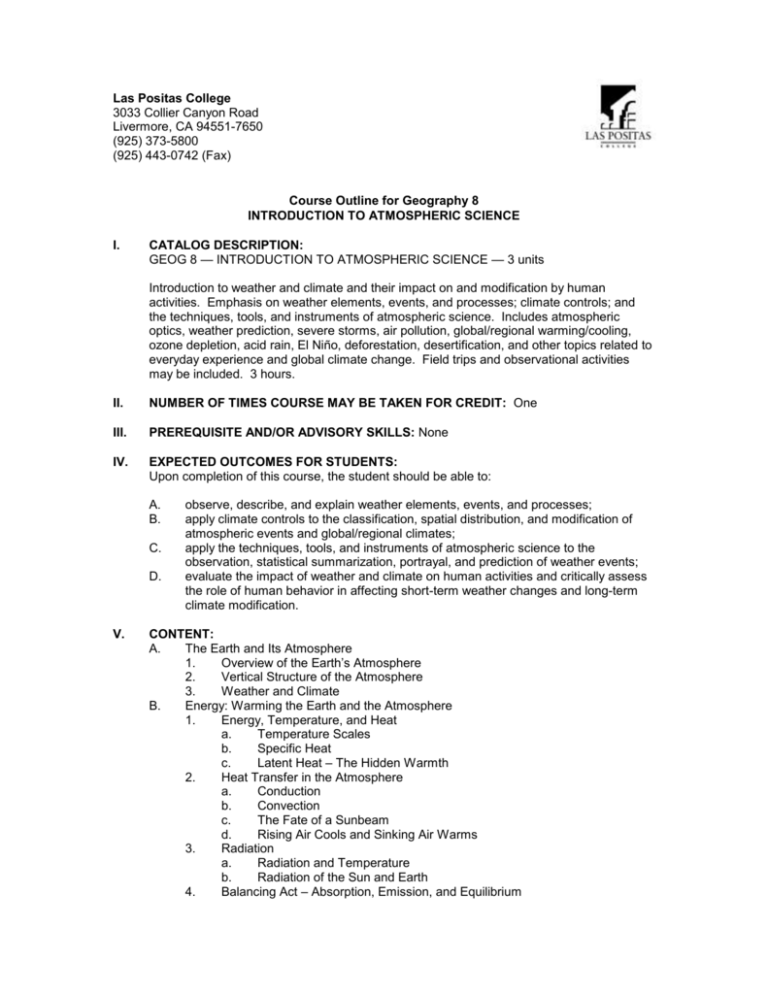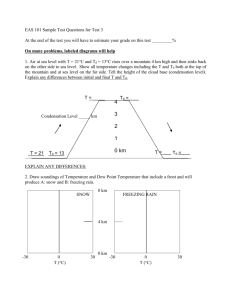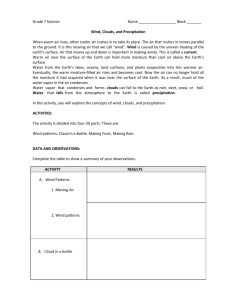Introduction to Weather and Climate
advertisement

Las Positas College 3033 Collier Canyon Road Livermore, CA 94551-7650 (925) 373-5800 (925) 443-0742 (Fax) Course Outline for Geography 8 INTRODUCTION TO ATMOSPHERIC SCIENCE I. CATALOG DESCRIPTION: GEOG 8 — INTRODUCTION TO ATMOSPHERIC SCIENCE — 3 units Introduction to weather and climate and their impact on and modification by human activities. Emphasis on weather elements, events, and processes; climate controls; and the techniques, tools, and instruments of atmospheric science. Includes atmospheric optics, weather prediction, severe storms, air pollution, global/regional warming/cooling, ozone depletion, acid rain, El Niño, deforestation, desertification, and other topics related to everyday experience and global climate change. Field trips and observational activities may be included. 3 hours. II. NUMBER OF TIMES COURSE MAY BE TAKEN FOR CREDIT: One III. PREREQUISITE AND/OR ADVISORY SKILLS: None IV. EXPECTED OUTCOMES FOR STUDENTS: Upon completion of this course, the student should be able to: A. B. C. D. V. observe, describe, and explain weather elements, events, and processes; apply climate controls to the classification, spatial distribution, and modification of atmospheric events and global/regional climates; apply the techniques, tools, and instruments of atmospheric science to the observation, statistical summarization, portrayal, and prediction of weather events; evaluate the impact of weather and climate on human activities and critically assess the role of human behavior in affecting short-term weather changes and long-term climate modification. CONTENT: A. The Earth and Its Atmosphere 1. Overview of the Earth’s Atmosphere 2. Vertical Structure of the Atmosphere 3. Weather and Climate B. Energy: Warming the Earth and the Atmosphere 1. Energy, Temperature, and Heat a. Temperature Scales b. Specific Heat c. Latent Heat – The Hidden Warmth 2. Heat Transfer in the Atmosphere a. Conduction b. Convection c. The Fate of a Sunbeam d. Rising Air Cools and Sinking Air Warms 3. Radiation a. Radiation and Temperature b. Radiation of the Sun and Earth 4. Balancing Act – Absorption, Emission, and Equilibrium Course Outline for Geography 8 INTRODUCTION TO ATMOSPHERIC SCIENCE C. D. E. F. a. Selective Absorbers and the Atmospheric Greenhouse Effect b. Enhancement of the Greenhouse Effect c. Warming the Air from Below 5. Incoming Solar Energy a. Scattered and Reflected Light b. The Earth’s Annual Energy Balance c. Solar Particles and Aurora Seasonal and Daily Temperatures 1. Why the Earth Has Seasons a. Seasons in the Northern Hemisphere b. Seasons in the Southern Hemisphere 2. Local Seasonal Variations a. Daytime Warming b. Nighttime Warming c. Radiation Inversions d. Protecting Crops from the Cold 3. The Controls of Temperature 4. Air Temperature Data a. Daily, Monthly, and Yearly Temperatures b. The Use of Temperature Data 5. Air Temperature and Human Comfort 6. Measuring Air Temperature Light, Color, and Atmospheric Optics 1. White and Colors 2. White Clouds and Scattered Light 3. Blue Skies and Hazy Days 4. Red Suns and Blue Moons 5. Twinkling, Twilight, and the Green Flash 6. The Mirage: Seeing Is Not Believing 7. Halos, Sundogs, and Sun Pillars 8. Rainbows 9. Coronas, Glories, and Heiligenschein Atmospheric Moisture 1. Water in the Atmosphere a. The Many Phases of Water b. Circulation of Water in the Atmosphere 2. Absolute Humidity 3. Specific Humidity and Mixing Ratio 4. Vapor Pressure 5. Relative Humidity a. Relative Humidity and Dew Point b. Comparing Humidities c. Relative Humidity in the Home d. Relative Humidity and Human Discomfort e. Measuring Humidity Condensation: Dew, Fog, and Clouds 1. The Formation of Dew and Frost 2. Condensation Nuclei 3. Haze 4. Fog a. Radiation Fog b. Advection Fog c. Upslope Fog d. Evaporation (Mixing) Fog 5. Foggy Weather 6. Clouds Page 2 Course Outline for Geography 8 INTRODUCTION TO ATMOSPHERIC SCIENCE G. H. I. J. a. Classification of Clouds b. Cloud Identification c. High Clouds d. Middle Clouds e. Low Clouds f. Clouds with Vertical Development g. Some Unusual Clouds h. Cloud Observations i. Determining Sky Conditions j. Satellite Observations Stability and Cloud Development 1. Atmospheric Stability 2. Determining Stability a. Stable Air b. A Stable Atmosphere c. Unstable Air d. Causes of Instability 3. Cloud Development a. Convection and Clouds b. Topography and Clouds c. Widespread Ascent and Clouds d. Changing Cloud Forms e. Mixing and Stratocumulus Precipitation 1. Precipitation Processes a. How Do Cloud Droplets Grow Larger? b. Collision and Coalescence Process c. Ice-Crystal Process d. Cloud Seeding and Precipitation e. Precipitation in Clouds 2. Precipitation Types a. Rain b. Snow c. Sleet and Freezing Rain d. Snow Grains and Snow Pellets e. Hail 3. Measuring Precipitation a. Instruments b. Doppler Radar and Precipitation The Atmosphere in Motion: Air Pressure, Forces, and Winds 1. Atmospheric Pressure a. Pressure Measurements b. Pressure Readings 2. Surface and Upper-Level Charts 3. Newton’s Laws of Motion 4. Forces the Influence the Winds a. Pressure Gradient Force b. Coriolis Force c. Straight-Line Flow Aloft – Geostrophic Winds d. Curved Winds Around Lows and Highs Aloft – Gradient Winds e. Winds on Upper-Level Charts f. Surface Winds 5. Winds and Vertical Air Motions Wind: Small-Scale and Local Systems 1. Small-Scale Winds Interacting with the Environment a. Scales of Motion Page 3 Course Outline for Geography 8 INTRODUCTION TO ATMOSPHERIC SCIENCE K. L. M. N. b. Friction and Turbulence in the Boundary Layer c. Eddies – Big and Small d. The Force of the Wind e. Microscale Winds Blowing over the Earth’s Surface 2. Determining Wind Direction and Speed a. The Influence of Prevailing Winds b. Wind Instruments 3. Local Wind Systems a. Thermal Circulations b. Sea and Land Breezes c. Local Winds and Water d. Seasonally Changing Winds – The Monsoon e. Mountain and Valley Breezes f. Katabatic Winds g. Chinook (Foehn) Winds h. Santa Ana Winds i. Other Local Winds of Interest Wind: Global Systems 1. General Circulation of the Atmosphere a. Single-Cell Model b. Three-Cell Model c. Average Surface Winds and Pressure: The Real World d. The General Circulation and Precipitation Patterns e. Average Wind Flow and Pressure Patterns Aloft 2. Jet Streams a. The Formation of the Polar Front Jet and the Subtropical Jet b. Other Jet Streams 3. Atmosphere-Ocean Interactions a. Global Wind Patterns and Surface Ocean Currents b. Upwelling 4. El Niño and the Southern Oscillation 5. Other Ocean Temperature Fluctuations and Climate Patterns Air Masses and Fronts 1. Air Masses a. Source Regions b. Classification c. Air Masses of North America 2. Fronts a. Stationary Fronts b. Cold Fronts c. Warm Fronts d. Occluded Fronts e. Upper Air Fronts Middle-Latitude Cyclones 1. Polar Front Theory 2. Where Do Mid-Latitude Storms Tend to Form? 3. Vertical Structure of Deep-Pressure Systems 4. Upper-Level Waves and Surface storms 5. The Necessary Ingredients for a Developing Wave Cyclone a. Upper-Air Support b. The Role of the Jet Stream c. The Conveyor Belt Model of Rising and Descending Air d. A Developing Wave-Cyclone – The March Storm of 1993 6. Polar Lows 7. Vorticity, Divergence, and Developing Storm Systems Weather Forecasting Page 4 Course Outline for Geography 8 INTRODUCTION TO ATMOSPHERIC SCIENCE 1. 2. O. P. Q. Acquisition of Weather Information Weather Forecasting Methods a. The Computer and Weather Forecasting: Numerical Weather Prediction b. Forecasting Tools c. Why Forecasts Go Awry and Steps to Improve Them d. Other Forecasting Methods e. Types of Forecasts f. Accuracy and Skill in Forecasting 3. Predicting the Weather from Local Signs 4. Weather Forecasting Using Surface Charts a. Determining the Movement of Weather Systems b. A Forecast for Six Cities 5. A Meteorologist Makes a Prediction a. Help from the 500-mb Chart b. The Computer Provides Assistance c. A Valid Forecast d. Assistance from the Satellite e. A Day of Rain and Wind Thunderstorms and Tornadoes 1. Thunderstorms a. Ordinary Thunderstorms b. Severe Thunderstorms c. The Gust Front and Microburst d. Mesoscale Convective Systems e. Squall Lines f. Mesoscale Convective Complexes (MCCs) g. Dryline Thunderstorms h. Thunderstorm Movement i. Floods and Flash Floods 2. Distribution of Thunderstorms a. Lightning and Thunder b. Electrification of Clouds c. The Lightning Stroke 3. Lightning Detection and Suppression 4. Tornadoes a. Tornado Occurrence b. Tornado Winds c. Seeking Shelter d. The Fujita Scale e. Tornadic Thunderstorms f. Favorable Atmospheric Conditions g. Supercell Tornadoes h. Nonsupercell Tornadoes 5. Severe Weather and Doppler Radar 6. Waterspouts Hurricanes 1. Tropical Weather 2. Anatomy of a Hurricane 3. Hurricane Formation and Dissipation a. Hurricane Stages of Development b. Hurricane Movement c. Destruction and Warning d. Modifying Hurricanes 4. Naming Hurricanes Air Pollution Page 5 Course Outline for Geography 8 INTRODUCTION TO ATMOSPHERIC SCIENCE 1. 2. R. S. VI. A Brief History of Air Pollution Types and Sources of Air Pollutants a. Principal Air Pollutants b. Ozone in the Troposphere c. Ozone in the Stratosphere d. Stratospheric Ozone: Production-Destruction e. Stratospheric Ozone – Upsetting the Balance f. Air Pollution: Trends and Patterns 3. Factors That Affect Air Pollution a. The Role of the Wind b. The Role of Stability and Inversions c. The Role of Topography d. Severe Air Pollution Potential 4. Air Pollution and the Urban Environment 5. Acid Deposition Global Climate 1. A World with Many Climates a. Global Temperatures b. The Hottest and Coldest Places on Earth c. Global Precipitation 2. Climatic Classification a. The Ancient Greeks b. The Köppen System c. Thornthwaite’s System 3. The Global Pattern of Climate a. Tropical Moist Climates (Group A) b. Dry Climates (Group B) c. Moist Subtropical Mid-Latitude Climates (Group C) d. Moist Continental Climates (Group D) e. Polar Climates (Group E) f. Highland Climates (Group H) Climate Change 1. The Earth’s Changing Climate a. Determining Past Climates b. Climate Through the Ages c. Climate During the Last 1000 Years 2. Possible Causes of Climatic Change a. Climate Change and Feedback Mechanisms b. Climate Change, Plate Tectonics, and Mountain Building c. Climate Change and Variations in the Earth’s Orbit d. Climate Change and Atmospheric Particles e. Aerosols in the Troposphere f. Volcanic Eruptions and Aerosols in the Stratosphere g. Climate Change and Variations in Solar Output 3. Global Warming a. The Recent Warming b. Radiative Forcing Agents c. Climate Models and Recent Temperature Trends d. Future Warming – Projections, Questions and Uncertainties e. Possible Consequences of Global Warming f. In Perspective METHODS OF INSTRUCTION: A. Lecture 1. Chalkboard (Whiteboard) Presentation 2. PowerPoint Presentations Page 6 Course Outline for Geography 8 Page 7 INTRODUCTION TO ATMOSPHERIC SCIENCE B. C. D. E. 3. Overhead Transparencies 4. Slides Discussion 1. Current Events 2. Current Weather & Forecasting 3. Demonstration of Instruments a. Anemometers b. Thermometers Field Trips 1. LLNL Emergency Response Unit 2. National Weather Service Office in Monterey, CA CD-ROM 1. Exploring Tropical Cyclones: GIS Investigations for the Earth Sciences 2. Blue Skies, College Edition Web-Based Resources 1. Unisys Weather: http://weather.unisys.com 2. National Weather Service: http://www.nws.noaa.gov/ 3. Brooks/Cole Earth Science Resource Center: http://earthscience.brookscole.com. VII. TYPICAL ASSIGNMENTS: A. Weekly Homework Assignments from Textbook 1. Write out the definitions of all the Key Terms at the end of Chapter 4. 2. Answer Questions for Review numbers 1 through 10. 3. Answer Questions for Thought numbers 1, 4, 7, 10, 12 and 14. 4. Complete Problems and Exercises number 3. B. Short-term Projects from the Student Workbook 1. Complete Unit 2: The Life of a Cyclone in the workbook Exploring Tropical Cyclones: GIS Investigations for the Earth Sciences. Work must be turned in three weeks from today’s date. C. Web-Based Assignment 1. Visit The Green Flash: http://mintaka.sdsu.edu/GF/. Using your own words, explain the principle behind the green flash. Where and when are you most likely to see it? How might you photograph it? Is it always green? 2. Visit Atmospheric Halos: http://dspace.dial.pipex.com/lc/halo/halosim.htm. Describe the relationship between the shape of ice crystals and the different types of halos. What types of halos have you seen? What were the atmospheric conditions at the time? VIII. EVALUATION: A. Methods 1. Homework 2. Student Projects 3. Quizzes/Exams 4. Final Exam B. Frequency 1. Weekly Homework Assignments 2. Recommend bi-weekly or tri-weekly quizzes and final exam (or) two or three midterm (unit) exams and final exam 3. Student Projects and/or Research Paper to be assigned at the discretion of the instructor. C. Typical Problems 1. Homework Problems a. Key Words i. crepuscular rays ii. mirage Course Outline for Geography 8 Page 8 INTRODUCTION TO ATMOSPHERIC SCIENCE 2. iii. Fata Morgana iv. Heiligenschein b. Questions for Review i. Explain why the sky is blue during the day and black at night. ii. What atmospheric conditions are necessary for an inferior mirage? A superior mirage? c. Questions for Thought i. How long does twilight last on the moon? (Hint: The moon has no atmosphere) ii. Explain why smoke rising from a cigarette often appears blue, yet appears white when blown from the mouth. d. Problems and Exercises i. At least 5 times a day go outside and gaze at the sky. In a notebook, record what you see. You will be amazed at what is there – crepuscular rays, halos, coronas, cloud iridescence, red sunsets, and more. ii. Take a large beaker or bottle and fill it with water. Add a small amount of nonfat powdered milk and stir until the water turns a faint milky white. Shine white light into the beaker, and, on the opposite side, hold a white piece of paper. (a) Explain why the milk has a blue cast to it and why the light shining on the paper appears ruddy. (b) What do you know about the size of the milk particles? (c) Is this a form of Rayleigh scattering or geometric scattering? Explain. (d) How does this demonstration relate to the color of the sky and the color of the sun – at sunrise and sunset? Exam Problems a. Multiple Choice Problems i. Snow will usually melt on the roof of a home that is a: (a) good radiator of heat. (b) good conductor of heat. (c) poor radiator of heat. (d) poor conductor of heat. ii. At the North Pole the sun will rise above the horizon on _______ and set below the horizon on _______. (a) June 22, September 23 (b) September 23, December 22 (c) March 21, September 2 (d) June 22, December 22 (e) March 21, December 22 b. Essay Questions i. Will a rising parcel of air always expand? Why? Does this expansion cause the air temperature to increase or decrease? Why? ii. What meteorological conditions contribute to the formation of a strong radiation inversion? Why? c. Image Questions i. Identify the time of day for the two halves of the diagram (circle one): (a) morning, afternoon, day, night (b) morning, afternoon, day, night Page 9 Course Outline for Geography 8 INTRODUCTION TO ATMOSPHERIC SCIENCE ii. Identify the correct front symbol by matching the letter with the front name: Warm front, Cold front, Stationary front, Occluded front IX. TYPICAL TEXTS: A. Ahrens, C. Donald. Meteorology Today: an Introduction to Weather, Climate, and the Environment. 7th Edition. Pacific Grove, CA: Brooks/Cole – Thompson Learning, 2003. B. Hall-Wallace, Michelle K. et. al. Exploring Tropical Cyclones: GIS Investigations for the Earth Sciences. 1st Edition. Ontario, Canada: Brooks/Cole – Thompson Learning, 2003. C. Ackerman, Steven; Knox, John. Meteorology – Understanding the Atmosphere. 1st Edition. Brooks/Cole – Thompson Learning, 2003. D. Computer and Internet access. X. OTHER MATERIALS REQUIRED OF STUDENTS: None Creation Date: 10/93 Revision Date: 11/04 Date Approved by Curriculum Committee: Effective Date: Fall 2005 12/08/04








